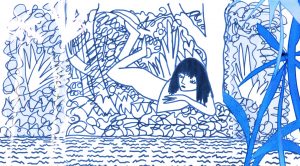It’s difficult to go very far and not run into an illustrated character that hasn’t breached the confines of its origins to become an icon or symbol of something beyond itself. While children latch on to the cute, the funny, and the relatable, increasingly adults are finding themselves enamored with characters they identify with.Even if you don’t know their names, the images of drawn characters are widely recognizable. There is a fascination with the cute and cuddly. The Japanese even have a word for it, kawaii, which doesn’t have a direct translation but pretty much means adorable. What is it about these characters that have found themselves deep in pop culture around the world? Below are five illustrated characters that have gone way beyond their origins.

Hello Kitty
Perhaps the most recognizable character around the world is Hello Kitty. Also known as Kitty White, Hello Kitty was created as a doll in the 1970s by Japanese company Sanrio and has remained in the imaginations of not just kids in Japan but for millions of people around the world.
The story, which may or may not be true, is that Hello Kitty doesn’t have a mouth because it was made to comfort a little girl who had oral cancer. But since then Hello Kitty has been featured nearly everywhere,and sold in every kind of product imaginable. There are even cafes and art shows dedicated to this cat. It was even made into an animated series in which the character talks even though it doesn’t have a mouth. Nowadays it is as recognizable as some of the most famous living people in the world.
Pusheen
You probably don’t know what Pusheen is, but you’ve definitely seen it. An adorable fat cat that was once the subject of a comic series is now an online sticker and meme sensation. Not only is the cat adorable, people began to identify with the themes that originated with the comic—laziness, eating, and household chores. This cat has become so famous since it was first created in 2010 that you can now find a full Pusheen store.
Gudetama
Another character loved for its laziness is Gudetama. A depressed, slovenly, and unenthusiastic egg yolk, Gudetama is another creation of Sanrio. It has gone far beyond the confines of Japan. There are entire stores dedicated to this sad egg yolk and a chain of curry restaurants dedicated to it. Gudetama has come to represent kawaii culture because it symbolizes the often unbearable sadness that comes with modern life in Japan. While in the United States and elsewhere it takes on a more positive tone, Gudetama’s origins are that of a severely depressed egg yolk.
Betty Boop
Originally inspired by a black woman, a cabaret singer named Baby Esther, Betty Boop became an early animated series and now a character that has been exported worldwide. While they changed the skin color and sexualized the character, Betty Boop is an endearing symbol of America not despite these contradictions but because of them. Once a flapper girl of the 20s, Betty Boop represents libertine freedoms and sexual liberation. It’s incongruous and unlikely, but over time people have forgotten her origins but still love her.
Felix the Cat
Nobody knows who created Felix the Cat, originally called Master Tom, another beloved feline character. Famous for appearances in early animated films, Felix’s likeness hasn’t changed much but his personality has gone from the early days of silent films stealing food from people to more innocent and childlike in the later years. While his creator is disputed, the longevity of a character from the silent films to remain today almost unchanged in appearance is amazing nonetheless.
What is it about these characters that lodge themselves in pop culture consciousness? Some are old and some are new, but they have all seemed to grab onto something in the hearts of people around the world. Is it their simplicity? Their childlike flaws and adorable appearance? Or is the fact that they’ve managed to transcend their origins and original meanings to become icons that remain simply because of their place in our imaginations? Whatever it is, these characters are deep inside the heart of pop culture and will likely remain for years to come.
Ryan Beitler is a writer, journalist, and blogger who has covered pop culture for many publications.









